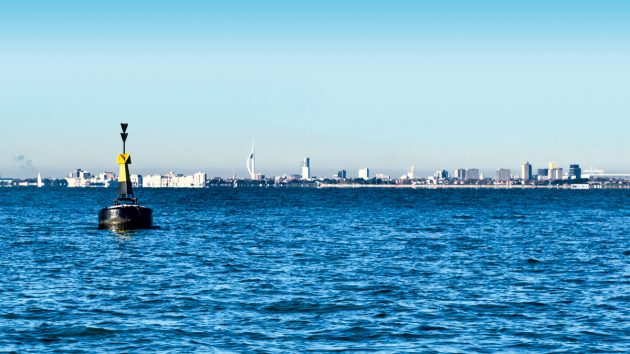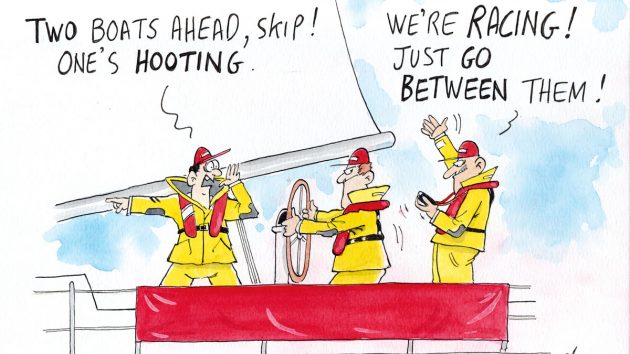Following a white knuckle marina rescue of three boats during Storm Eunice, Gilbert Park experiences two fairer weather towing adventures
Two more boat rescues – this time without a big storm – were to teach me a lesson in towing.
The first occurred when I went away for a few days in my former boat, a Trusty T23, just before Easter.
I spent the night of Good Friday at anchor in Chichester Harbour near Itchenor so I could be home on the lunch-time tide on the Saturday (my mooring is only available 1.5hr each side of HW).
I took the anchor up, allowing plenty of time to get home, I decided to cross the drying mud at Pilsey Sand as there was a good depth of water and I could see lots of sailing boats doing the same.

The Mitchell 28 Classique Argus used to tow the fishing boat to Southsea. Unfortunately, I wasn’t able to take pictures at the time – I was a bit busy as I had no crew
I noticed a Drascombe Coaster, a boat I have fond memories of, having owned one about 35 years ago.
It was blowing a Force 4 gusting 5 and only the jib and mizzen were in use, but she was not moving very fast. I waved at the only person on board and he waved back.
On I went, but I noticed he was still waving. Being curious I turned back, the sailor was still waving.
It transpired that something had happened to his centreboard and he had been stuck in the mud for two hours.
His outboard wasn’t working so could I give him a tow?
Racing risk
I did think of a bridle, but figured it was a short tow and didn’t use one.
I went alongside and collected his long rope with a metal clip that I attached to a locking, mooring cleat. When he was ready, off we went.
A racing fleet appeared and like a swarm of locusts gathered around us. I knew they would expect me to get out of their way, but as I was towing I couldn’t.
The risk of one of them careering into the tow rope, as well as the two boats, worried me.
I didn’t have a day sign for towing on board, so I decided to use a sound signal.
The appropriate one for restricted ability to manoeuvre is three blasts, one long and two short, at intervals of not more than two minutes (Rule 35).
I’m not sure it was understood, but one of the safety boats accompanying the racing fleet took action to warn competitors that I could not get out of their way.
Once in deeper water the sailor of the Drascombe decided to drop anchor, but didn’t tell me. So we stopped moving!
Fortunately, we were only travelling at one knot so no damage was done to either boat.
The Drascombe’s home port was at Dell Quay, the opposite way to where I had to go.
Normally I’d have towed her there, but that would mean not getting home as promised.
A quick call to Chichester Harbour Radio and they agreed to take over the tow.
Returning the Drascombe’s tow line was difficult because I couldn’t get the clip undone (the wind was keeping the line taught).
The tow rope also caught on the canopy and threatened to rip it. I used the experience to write myself a towing checklist.
Unexpected stop
A few months later I was on my way to take my wife Christmas shopping in Portsmouth (from Chichester Harbour in my Mitchell 28) and to spend the night under the Emirates Spinnaker Tower in Gunwharf Quay Marina.
Just off Langstone Harbour I heard a call for help from a fisherman, just south of Winners Cardinal Marker.
Both of his outboard motors had failed. Over the radio I offered to give him a tow to Southsea Marina.
I was by myself (my wife having opted to go quicker by car) and got the towing checklist out.

Winner South Cardinal Marker where the small fishing boat got into trouble. Portsmouth can be seen in the background
The sea had kicked up that afternoon and there was a moderate sea that made getting parallel to pass a heaving line tricky.
If I was doing this again I’d pass the line from my boat to his by crossing the top of a T. Once the tow rope (made up from mooring warps) had been passed the tow started.
It went uneventfully to Southsea Marina where I dropped him off.
What had I learnt from my fifth rescue of the year?
The checklist worked, but I have added to it exactly where the bridle and long tow rope was stored.
Being alone, I was unable to look through the various lockers to find it.
As for Christmas shopping, my wife had been seriously delayed in a huge traffic jam so only got there just in time to buy my present before I arrived!
Towing Lessons Learned
- Don’t use a clip to secure a tow line to a cleat. You may have difficulty undoing it under load. An OXO turn of a rope around a cleat can easily be undone.
- If you’re not using a bridle undo the fastenings for any canopy so the tow rope does not get caught in it and rip it.
- Have a copy of the sound (and day) signals available either in an almanac or as a separate card.
- Maintain communication with the boat being towed. Radio is one option, an alongside tow or a stern helm.
- Make sure everyone is wearing a lifejacket.
- Continues below…
[collection name=small
Enjoyed reading ‘Towing the Drascombe, a racing fleet appeared and like a swarm of locusts gathered around us’?
A subscription to Practical Boat Owner magazine costs around 40% less than the cover price.
Print and digital editions are available through Magazines Direct – where you can also find the latest deals.
PBO is packed with information to help you get the most from boat ownership – whether sail or power.
-
-
-
- Take your DIY skills to the next level with trusted advice on boat maintenance and repairs
- Impartial in-depth gear reviews
- Practical cruising tips for making the most of your time afloat
-
-





